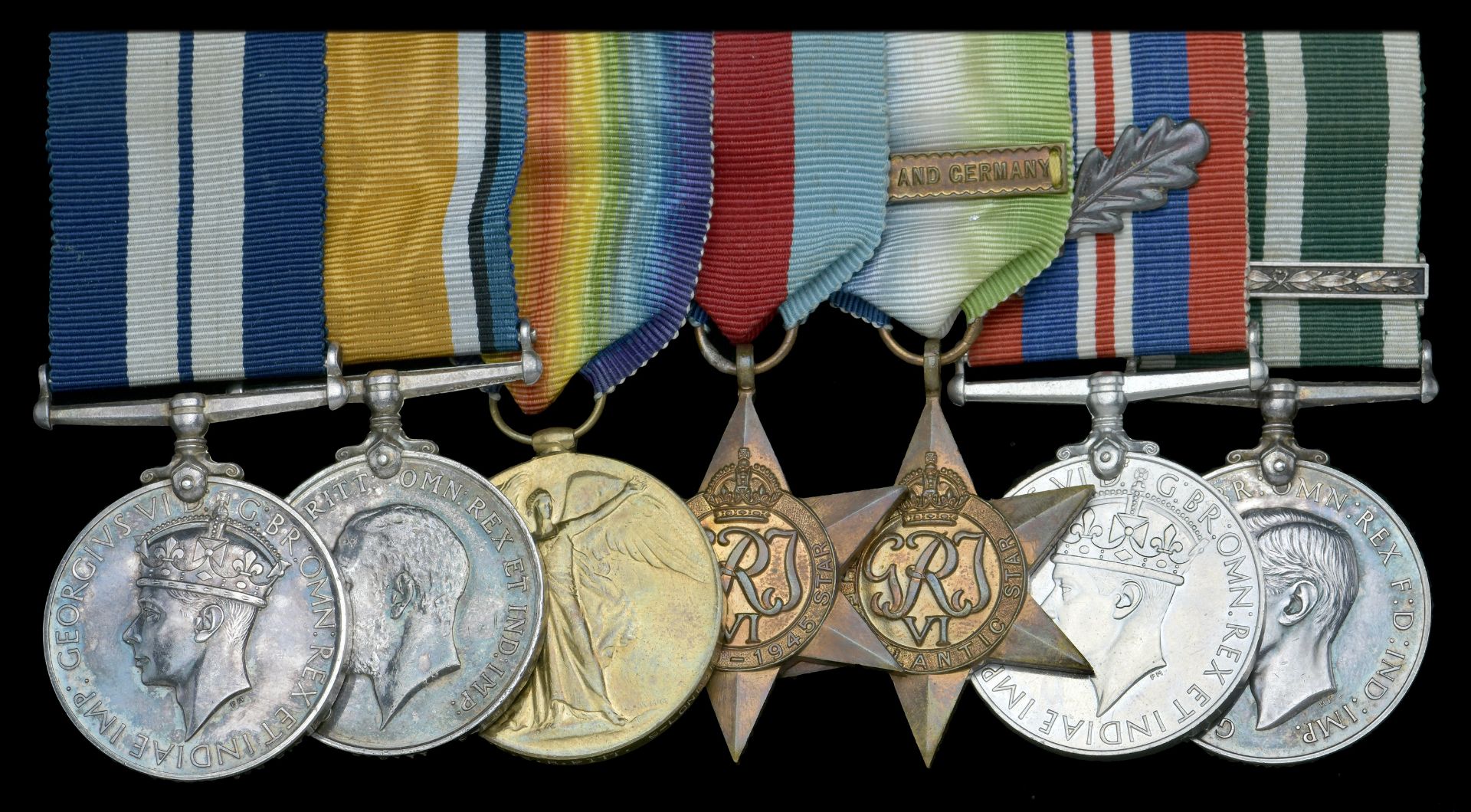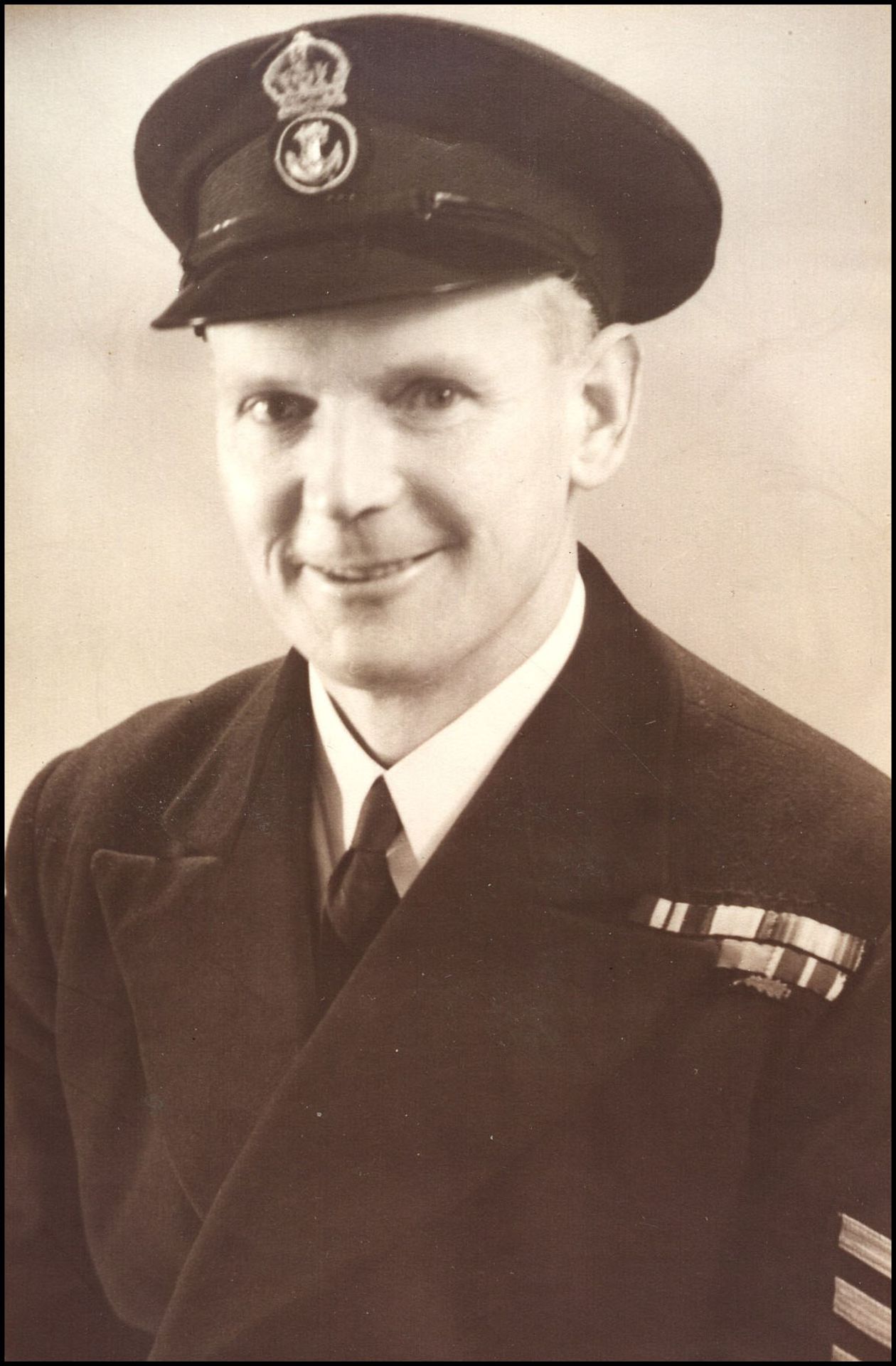A Second War D.S.M. group of seven awarded to Leading Seaman E. R. Pitt, Royal Naval Reserve, late 9th Battalion, London Regiment, who was wounded in the Great War, and took part in H.M.S. Ayrshire’s epic voyage to Archangel in the Second World War Distinguished Service Medal, G.VI.R. (L.5704 D., E. R. Pitt. L.Smn. R.N.R.); British War and Victory Medals (6739 Pte. E. R. Pitt. 9-Lond. R.); 1939-45 Star; Atlantic Star, 1 clasp, France and Germany; War Medal 1939-45, with M.I.D. oak leaf; Royal Naval Reserve L.S. & G.C., G.VI.R., 1st issue, with Second Award Bar (5704D. E. R. Pitt. Smn. R.N.R.) mounted as worn; together with the recipient’s Great War Silver War Badge, good very fine (8) £1,200-£1,600 --- D.S.M. London Gazette 11 June 1942. M.I.D. London Gazette 1 July 1941. Edward Robert Pitt was born in Wivenhoe, Essex, on 30 January 1899. During the Great War he served with the 9th Battalion London Regiment, but was severely wounded in 1917 and was discharged from the Army, being awarded a Silver War Badge. Enlisting in the Royal Naval Reserve, he served during the Second World War in H.M.S. Gavotte from 1940 to 1941, and H.M.S. Ayrshire from 1941 to 1945, both armed trawlers that served on the incredibly arduous and dangerous convoy duties in the North Atlantic and Arctic Oceans. During this time the convoys were under constant threat and attack from German U-boats, surface ships, and air attack. Adding to this, the atrocious weather conditions to contend with, all on a relatively lightly armed and small ship, it really must have been as Churchill said; ‘the worst journey in the world’. The following is an extract account of his life and service as taken from documents held by his family: ‘He ran away from home at the age of 15 and joined the army going into the Rifle Brigade, but was found to be underage and was bought out by his grandmother. When he became of age he re-enlisted into the 9th London Regiment. His re-enlistment came at the time when some of the bloodiest battles of the Great War were being fought and he was severely wounded during one of these in 1917. He was then discharged from the Army. After the Great War he joined the Merchant Navy and travelled the World over... At the outbreak of the Second World War he was recalled to active service and served in the Royal Navy and became Leading Seaman on H.M.S. Gavotte, a converted trawler, this ship on convoy escort duties in the North Atlantic. He was Mentioned in Despatches in 1941. Between 1941 and 1945 he served in H.M.S. Ayrshire, this also being an armed trawler working on convoy duties between Scotland and Murmansk. He finished the War as a Chief Petty Officer, being awarded the Distinguished Service Medal by King George VI at Buckingham Palace.’ A photograph within the group shows Pitt manning an anti aircraft gun aboard a trawler which would suggest this was one of his duties aboard ship. Given his previous Army service, this is quite likely. H.M.S. Ayrshire ‘In June 1942 Lieutenant Leo Gradwell was in command of the H.M.S. Ayrshire, a small (roughly 500 tons) converted fishing trawler forming part of the anti-submarine screening force for Admiralty convoy PQ-17 departing for Archangel in the Soviet Union with much needed war supplies on 27 June 1942. Arctic convoys at this time had to be concerned not only with Luftwaffe and U boat attacks but also the attentions of major German surface units, including the Tirpitz. The convoy therefore had a heavy escort force following it in addition to a light close escort of destroyers, corvettes and trawlers such as the Ayrshire. However, the heavy escort fell behind just as luck would have it, that air reconnaissance of German bases was prevented by bad weather. On 3 July, a reconnaissance plane finally made it to Trondheim, home of the Tirpitz, and found to the Admiralty's horror that the Tirpitz had gone, as well as her cruiser screen. With a large raiding force at sea, and unable to know precisely were it was, and with the heavy escort force too far away to reach the convoy in time, an order was given to scatter the convoy. What followed was largely a disaster: the Tirpitz never showed up; the Germans having thought the convoy was bait for a trap and turned away; and the scattered merchant ships were easy prey for both bombers and U boats. This is where the remarkable story of H.M.S. Ayrshire begins. With the convoy ordered to scatter Gradwell decided to head directly north towards the pack ice east of Svalbard, and persuaded three of the scattering freighters to follow him: the Panamanian registered Troubador, the Ironclad, and the United states registered Silver Swor. None of the three ships or their tiny escort had charts for this area, since it was well off the planned convoy route, and so Gradwell had to navigate their course using only a Sextant and a copy of The Times World Geographic Pocket Book. On reaching the pack ice, the unlikely flotilla became stuck fast in the ice unable to move. Gradwell took overall command as the senior naval officer present and organised the ships to defend themselves. Taking stock it was discovered that the Troubadour was carrying a cargo of bunkering coal and white paint. Gradwell ordered the paint supplies opened and soon all four vessels were painted white, with white sheets over the decks to camouflage them from Luftwaffe bombers. He also ordered the freighters to move around their deck cargo of Sherman tanks into defensive rings pointing outwards with their main guns loaded turning them into improvised gun turrets. After several days stuck fast the camouflage proved effective, in that they were never spotted or attacked. Finally, upon breaking free of the ice, Gradwell lead his three merchant ships across the Barents sea to the Matochkin Straight where they were met by a force of Soviet navy corvettes who accompanied the rag tag convoy to the port of Archangel, arriving on 25 July 1942.’ Sold with the recipient’s riband bars, cap badges, and identity tags; Mentioned in Despatches Certificate; photographs of the recipient, including one of him outside Buckingham Palace having been invested with his D.S.M.; a large amount of research including accounts of Pitt’s service; and other ephemera.







